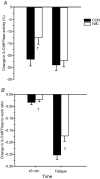N-acetylcysteine attenuates the decline in muscle Na+,K+-pump activity and delays fatigue during prolonged exercise in humans
- PMID: 16840514
- PMCID: PMC1995650
- DOI: 10.1113/jphysiol.2006.115352
N-acetylcysteine attenuates the decline in muscle Na+,K+-pump activity and delays fatigue during prolonged exercise in humans
Abstract
Reactive oxygen species (ROS) have been linked with both depressed Na(+),K(+)-pump activity and skeletal muscle fatigue. This study investigated N-acetylcysteine (NAC) effects on muscle Na(+),K(+)-pump activity and potassium (K(+)) regulation during prolonged, submaximal endurance exercise. Eight well-trained subjects participated in a double-blind, randomised, crossover design, receiving either NAC or saline (CON) intravenous infusion at 125 mg kg(-1) h(-1) for 15 min, then 25 mg kg(-1) h(-1) for 20 min prior to and throughout exercise. Subjects cycled for 45 min at 71% , then continued at 92% until fatigue. Vastus lateralis muscle biopsies were taken before exercise, at 45 min and fatigue and analysed for maximal in vitro Na(+),K(+)-pump activity (K(+)-stimulated 3-O-methyfluorescein phosphatase; 3-O-MFPase). Arterialized venous blood was sampled throughout exercise and analysed for plasma K(+) and other electrolytes. Time to fatigue at 92% was reproducible in preliminary trials (c.v. 5.6 +/- 0.6%) and was prolonged with NAC by 23.8 +/- 8.3% (NAC 6.3 +/- 0.5 versus CON 5.2 +/- 0.6 min, P < 0.05). Maximal 3-O-MFPase activity decreased from rest by 21.6 +/- 2.8% at 45 min and by 23.9 +/- 2.3% at fatigue (P < 0.05). NAC attenuated the percentage decline in maximal 3-O-MFPase activity (%Deltaactivity) at 45 min (P < 0.05) but not at fatigue. When expressed relative to work done, the %Deltaactivity-to-work ratio was attenuated by NAC at 45 min and fatigue (P < 0.005). The rise in plasma [K(+)] during exercise and the Delta[K(+)]-to-work ratio at fatigue were attenuated by NAC (P < 0.05). These results confirm that the antioxidant NAC attenuates muscle fatigue, in part via improved K(+) regulation, and point to a role for ROS in muscle fatigue.
Figures




Comment in
-
Muscle fatigue and reactive oxygen species.J Physiol. 2006 Oct 1;576(Pt 1):1. doi: 10.1113/jphysiol.2006.118083. Epub 2006 Aug 10. J Physiol. 2006. PMID: 16901938 Free PMC article. No abstract available.
Similar articles
-
N-acetylcysteine enhances muscle cysteine and glutathione availability and attenuates fatigue during prolonged exercise in endurance-trained individuals.J Appl Physiol (1985). 2004 Oct;97(4):1477-85. doi: 10.1152/japplphysiol.00371.2004. Epub 2004 Jun 11. J Appl Physiol (1985). 2004. PMID: 15194675 Clinical Trial.
-
Effects of intravenous N-acetylcysteine infusion on time to fatigue and potassium regulation during prolonged cycling exercise.J Appl Physiol (1985). 2004 Jan;96(1):211-7. doi: 10.1152/japplphysiol.00458.2003. Epub 2003 Sep 5. J Appl Physiol (1985). 2004. PMID: 12959960 Clinical Trial.
-
Prolonged exercise to fatigue in humans impairs skeletal muscle Na+-K+-ATPase activity, sarcoplasmic reticulum Ca2+ release, and Ca2+ uptake.J Appl Physiol (1985). 2004 Oct;97(4):1414-23. doi: 10.1152/japplphysiol.00964.2003. Epub 2004 May 21. J Appl Physiol (1985). 2004. PMID: 15155714 Clinical Trial.
-
Ion gradients and contractility in skeletal muscle: the role of active Na+, K+ transport.Acta Physiol Scand. 1996 Mar;156(3):247-56. doi: 10.1046/j.1365-201X.1996.204000.x. Acta Physiol Scand. 1996. PMID: 8729684 Review.
-
Skeletal muscle fatigue in normal subjects and heart failure patients. Is there a common mechanism?Acta Physiol Scand. 1998 Mar;162(3):215-28. doi: 10.1046/j.1365-201X.1998.0343f.x. Acta Physiol Scand. 1998. PMID: 9578367 Review.
Cited by
-
Ergothioneine Improves Aerobic Performance Without Any Negative Effect on Early Muscle Recovery Signaling in Response to Acute Exercise.Front Physiol. 2022 Feb 9;13:834597. doi: 10.3389/fphys.2022.834597. eCollection 2022. Front Physiol. 2022. PMID: 35222093 Free PMC article. Review.
-
Reactive oxygen species activate the group IV muscle afferents in resting and exercising muscle in rats.Pflugers Arch. 2009 Nov;459(1):143-50. doi: 10.1007/s00424-009-0713-8. Epub 2009 Aug 23. Pflugers Arch. 2009. PMID: 19701650
-
Muscle fatigue: from observations in humans to underlying mechanisms studied in intact single muscle fibres.Eur J Appl Physiol. 2010 Sep;110(1):1-15. doi: 10.1007/s00421-010-1480-0. Epub 2010 Apr 24. Eur J Appl Physiol. 2010. PMID: 20419312 Review.
-
Effectiveness of sulfur-containing antioxidants in delaying skeletal muscle fatigue.Med Sci Sports Exerc. 2011 Jun;43(6):1025-31. doi: 10.1249/MSS.0b013e3182019a78. Med Sci Sports Exerc. 2011. PMID: 20980926 Free PMC article.
-
Regulation of muscle potassium: exercise performance, fatigue and health implications.Eur J Appl Physiol. 2021 Mar;121(3):721-748. doi: 10.1007/s00421-020-04546-8. Epub 2021 Jan 4. Eur J Appl Physiol. 2021. PMID: 33392745 Review.
References
-
- Aruoma OI, Halliwell B, Hoey BM, Butler J. The antioxidant action of N-acetylcysteine: its reaction with hydrogen peroxide, hydroxyl radical, superoxide, and hypochlorous acid. Free Rad Biol Med. 1989;6:593–597. - PubMed
-
- Aughey RJ, Gore CJ, Hahn AG, Garnham AP, Clark SA, Petersen AC, Roberts AD, McKerra MJ. Chronic intermittent hypoxia and incremental cycling exercise independently depress muscle in-vitro maximal Na+-K+-ATPase activity in well-trained athletes. J Appl Physiol. 2005;98:186–192. - PubMed
-
- Bailey DM, Davies B, Young IS, Jackson MJ, Davison GW, Isaacson R, Richardson RS. EPR spectroscopic detection of free radical outflow from an isolated muscle bed in exercising humans. J Appl Physiol. 2003;94:1714–1718. - PubMed
-
- Beltowski J, Marciniak A, Wojcicka G, Gorny D. Nitric oxide decreases renal medullary Na+,K+-ATPase activity through cyclic GMP-protein kinase G dependent mechanism. J Physiol Pharmacol. 2003;54:191–210. - PubMed
-
- Boldyrev AA, Bulygina ER. Na/K-ATPase and oxidative stress. Ann N Y Acad Sci. 1997;834:666–668. - PubMed
Publication types
MeSH terms
Substances
LinkOut - more resources
Full Text Sources
Other Literature Sources

